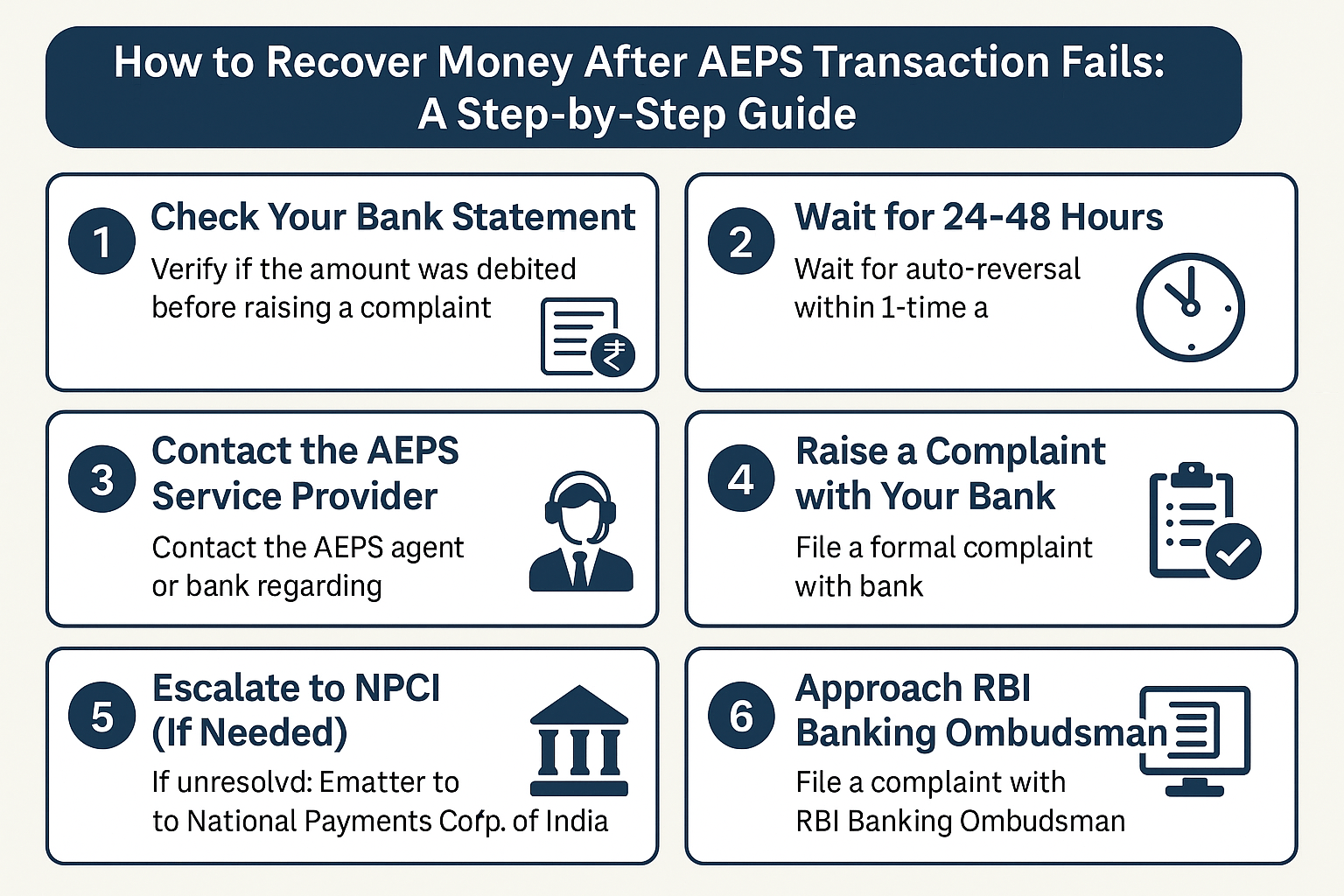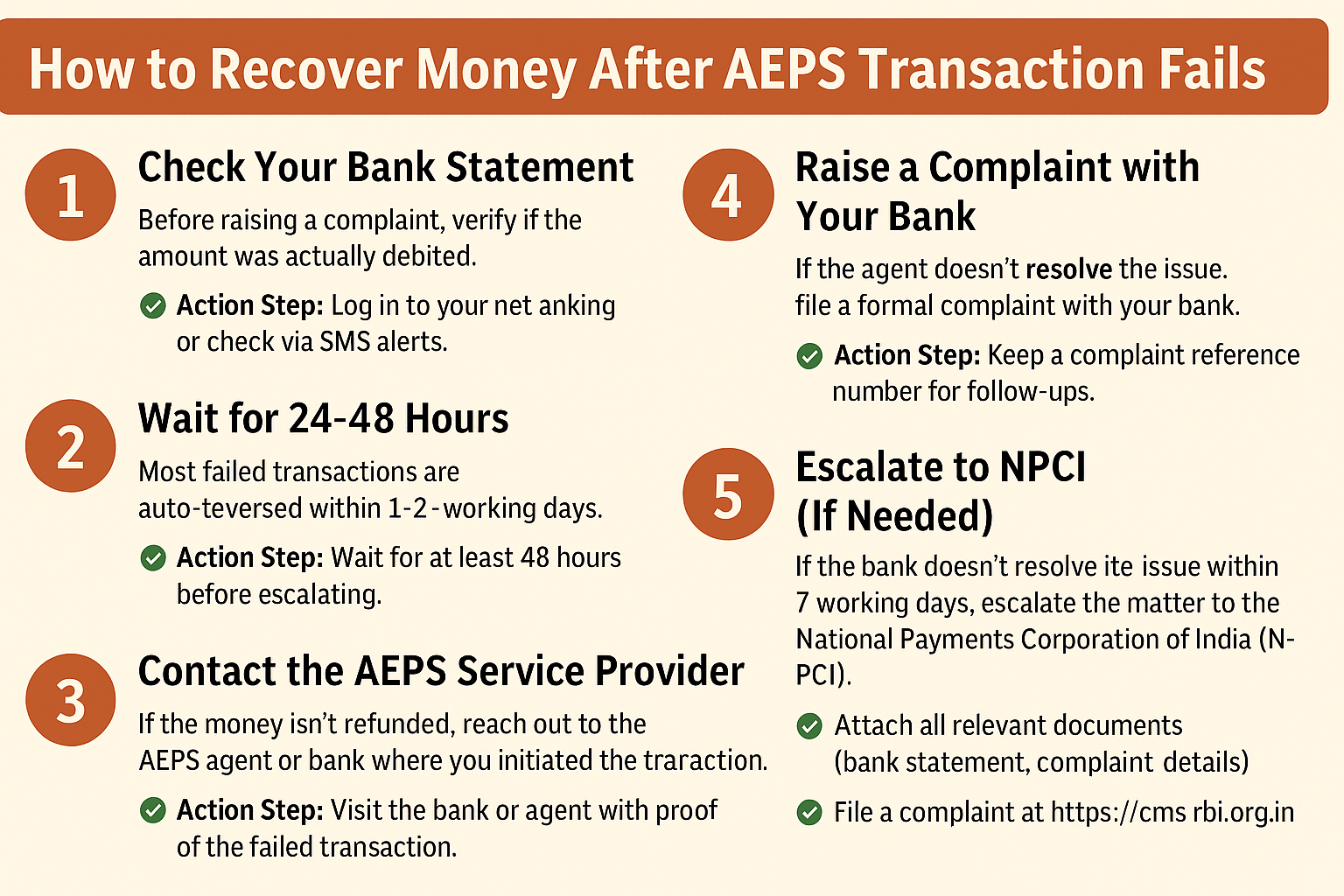Aadhaar Enabled Payment System (AEPS) is a convenient way to perform banking transactions using just your Aadhaar number and fingerprint. However, sometimes AEPS transactions fail, leaving users worried about their money. If you’ve faced this issue, don’t panic—there are ways to recover money after an AEPS transaction fails.
In this guide, we’ll walk you through the exact steps to get your money back, explain why these failures happen, and share tips to avoid them in the future.
Why Do AEPS Transactions Fail?
Before diving into recovery, it’s important to understand why AEPS transactions fail in the first place. Common reasons include:
-
Insufficient Balance – If your bank account doesn’t have enough funds, the transaction will fail.
-
Biometric Mismatch – Fingerprint authentication errors can lead to failed transactions.
-
Bank Server Issues – Technical glitches in the bank’s system may disrupt transactions.
-
Aadhaar Linking Problems – If your Aadhaar isn’t properly linked to your bank account, the transaction won’t go through.
-
Network Problems – Poor internet connectivity can interrupt the transaction process.
When a transaction fails, the money is usually reversed automatically within 24-48 hours. If it doesn’t, you’ll need to take action.

How to Recover Money After AEPS Transaction Fails
1. Check Your Bank Statement
Before raising a complaint, verify if the amount was actually debited. Sometimes, the transaction fails instantly, and no money is deducted.
✅ Action Step: Log in to your net banking or check via SMS alerts.
2. Wait for 24-48 Hours
Most failed transactions are auto-reversed within 1-2 working days. Banks have systems in place to detect failed transactions and refund the amount.
✅ Action Step: Wait for at least 48 hours before escalating.
3. Contact the AEPS Service Provider
If the money isn’t refunded, reach out to the AEPS agent or bank where you initiated the transaction. Provide:
-
Transaction ID
-
Aadhaar Number
-
Date & Time of Transaction
✅ Action Step: Visit the bank or agent with proof of the failed transaction.
4. Raise a Complaint with Your Bank
If the agent doesn’t resolve the issue, file a formal complaint with your bank. Most banks have:
-
Customer care helpline (call or email)
-
Online grievance portal (via net banking)
-
Branch visit (for immediate assistance)
✅ Action Step: Keep a complaint reference number for follow-ups.
5. Escalate to NPCI (If Needed)
If the bank doesn’t resolve the issue within 7 working days, escalate the matter to the National Payments Corporation of India (NPCI).
-
Email: complaints@npci.org.in
-
Helpline: 0120-3960307
✅ Action Step: Attach all relevant documents (bank statement, complaint details).
6. Approach RBI Banking Ombudsman
If even NPCI doesn’t help, you can file a complaint with the RBI Banking Ombudsman. This is a last resort for unresolved banking disputes.
✅ Action Step: File a complaint at https://cms.rbi.org.in.
How to Avoid AEPS Transaction Failures?
Prevention is better than cure. Follow these tips to minimize AEPS transaction failures:
✔ Ensure Sufficient Balance – Check your account before transacting.
✔ Update Aadhaar-Bank Link – Verify Aadhaar seeding with your bank.
✔ Use Correct Fingerprint – Clean your fingers and place them properly on the scanner.
✔ Stable Network Connection – Avoid AEPS transactions in poor network areas.

Frequently Asked Questions (FAQs)
1. How long does it take to get a refund after an AEPS failure?
Most refunds happen within 24-48 hours. If not, contact your bank.
2. What if the bank denies a refund for a failed AEPS transaction?
Escalate to NPCI and then RBI Ombudsman if unresolved.
3. Can I track a failed AEPS transaction?
Yes, use the transaction ID to check with your bank or AEPS provider.
4. Do I need to visit the bank for a failed AEPS transaction?
Not always—first try calling customer care or checking online.
Final Thoughts
Failed AEPS transactions can be stressful, but in most cases, the money is refunded automatically. If not, follow the steps above—check statements, contact your bank, escalate to NPCI, and approach RBI if needed.
By staying informed and proactive, you can recover money after an AEPS transaction fails without unnecessary delays.
Disclaimer
This post is for educational purposes only. If you have any concerns regarding the content, please visit our DMCA page for removal requests. Always verify banking processes with official sources before taking action.
